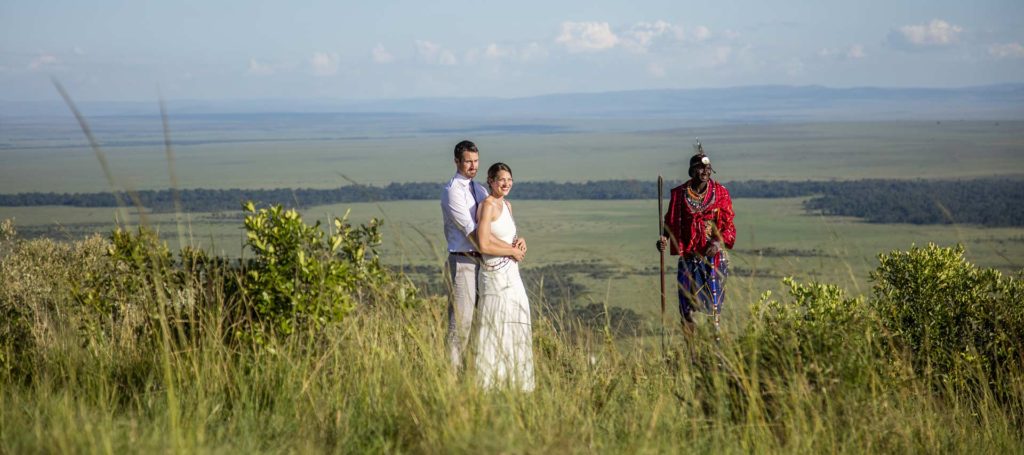
Planning a Maasai wedding
It’s the latest craze: today’s couples are looking to get married in quirky, if not downright strange, venues. Some shiver in Swedish ice hotels, others quiver in shark tanks. Two patient couples are already booked on the Virgin Galactic space flight. In Kenya, you can get married in a cave; or ringside to the great migration of the wildebeest. Hardy couples get hitched having hiked up Mount Kenya, or dive into matrimony beneath the waves. Topping the popular charts, however, is a Maasai wedding in the wilderness - the cherry on the top of the global wedding cake. It’s a magical option and, as with all Maasai ceremonies, the wedding will be a riot of sound, colour and joy.
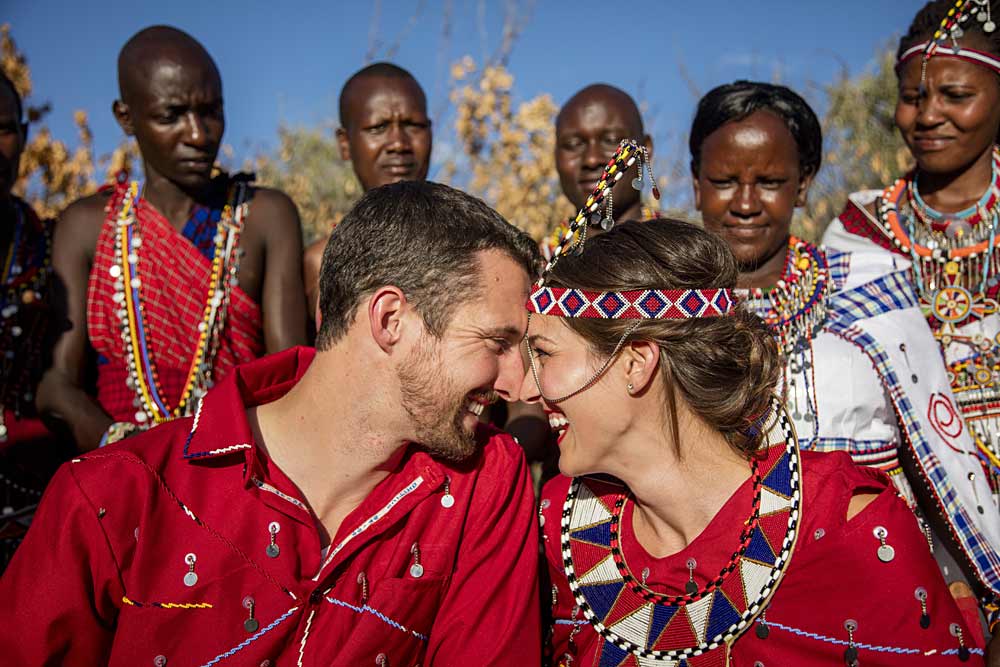
In its simplest form, the Maasai wedding is much like any other, except that the bride and groom might wear some items of Maasai dress – such as a colourful red shuka or cloak. Many couples also choose to wear some items of traditional Maasai beaded-jewellery – such as necklaces or, in the case of the bride, a traditional headdress.
But there are many other ways of giving your ceremony a more distinctive Maasai flair. Here are a few suggestions.
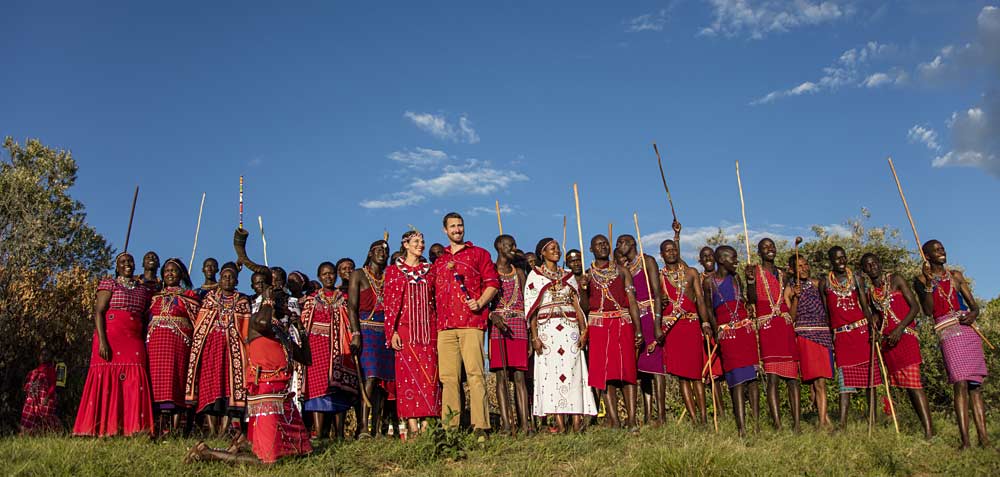
A guard of honour
If you’d like to arrive at the site chosen for the ceremony with a Maasai guard of honour, this is easily arranged. Typically, a group of morans (warriors) will arrive in traditional dress and escort the groom to meet his bride. They’ll sing as they walk and, after the ceremony, they’ll often give a display of jumping and dance. The groom is invited to join in.
In many unions, the groom is also presented with a ceremonial beaded stick, or sometimes two sticks – a white one to symbolize wealth, a black one to symbolize peace.
A choir of maidens
It makes a glorious addition to your special day – a group of 15-20 traditionally clad girls who arrive to sing a traditional wedding song, dancing as they do so. Later the girls will dance with the warriors, which creates a superb photo opportunity.
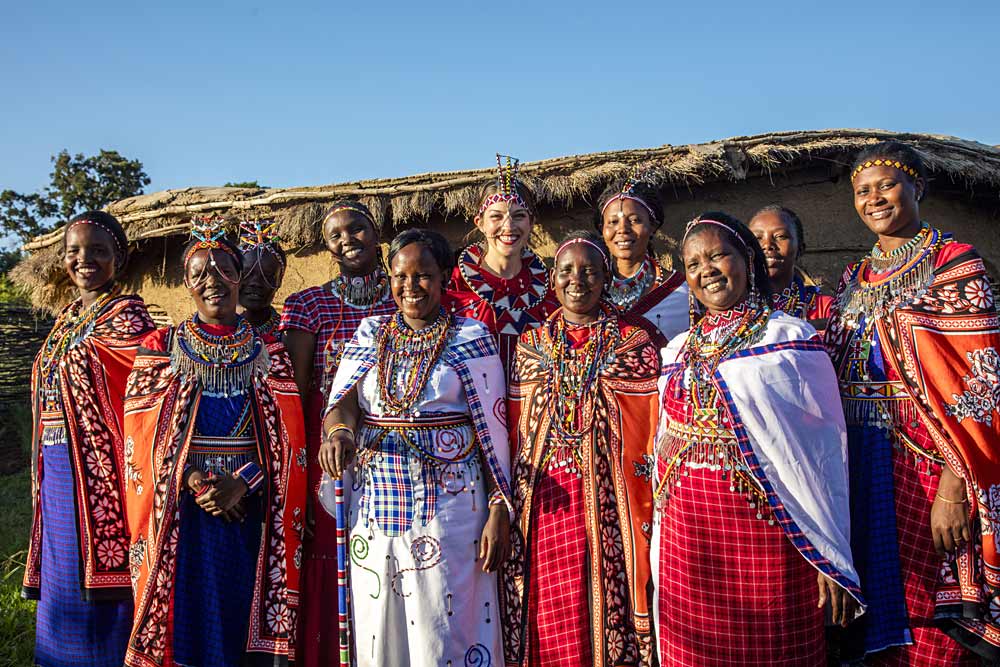
A Maasai bower
A popular option offered by many safari lodges is the construction of a beautifully beaded bower for the ceremony. An arched replica of a traditional necklace, it will be intricately patterned in beads and hung with tiny sparkling talismans.
Be married by a Maasai elder
Many couples elect to be married by a Maasai elder (though their union will be formalized by a registrar before or after this ceremony). The presiding elder will shake a cow-tail switch over the couple and wish them a long and safe life. These are the words that are spoken by the elder:
Entaseriana – Be safe forever
Entobikoi – Have a long life
Entubul emputa enkop – Multiply and fill the earth
Meishuro Nkera Inyi – May your children succeed in life
Metapaasha Intae Ilmeita – May all bad things move away from your family
Entorik Enkop – May you lead the world
To which the bride, groom and wedding party answered in unison: NAAI – Oh God. Finally, the bride will be given a Maasai name, such as Nalotuesha, which means ‘she who comes with the rain’.
With the ceremony over, the reception can take place either indoors or outdoors under the shade of acacia or a starlit African sky.
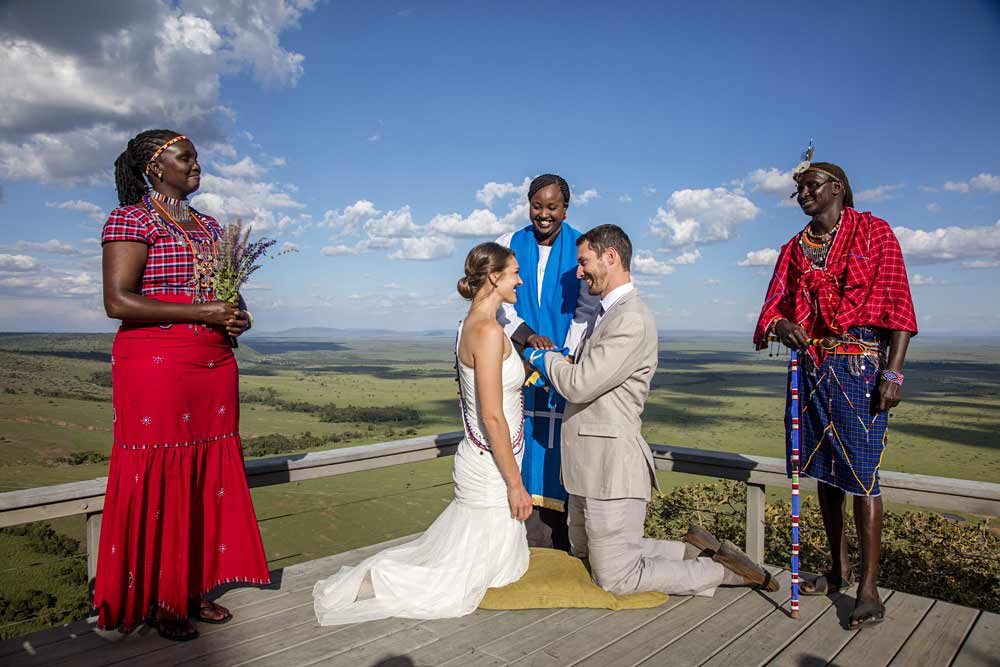
Maasai weddings - Need to know
In order to get married in Kenya you must have the following:
• Copies of birth certificates and passports which will need to be sent in advance and originals for when you are in Kenya;
• A certificate of no impediment to marriage;
• An affidavit declaring single status authorised by a notary (your local vicar or pastor for instance) or solicitor declaring eligibility for marriage;
• If divorced, you will need to present a Decree Absolute that has been stamped by the courts;
• If you have changed your name by Deed Poll, or you were adopted, proof of this needs to be presented having been authenticated by a notary or solicitor;
• A letter stating names, addresses and occupation of the couple and both sets of parents;
• And if either of you are under 21 years of age you will need written consent from your parents or guardians in the form of an affidavit authorised by a notary or a solicitor;
• You should also provide 3 colour passport photos.
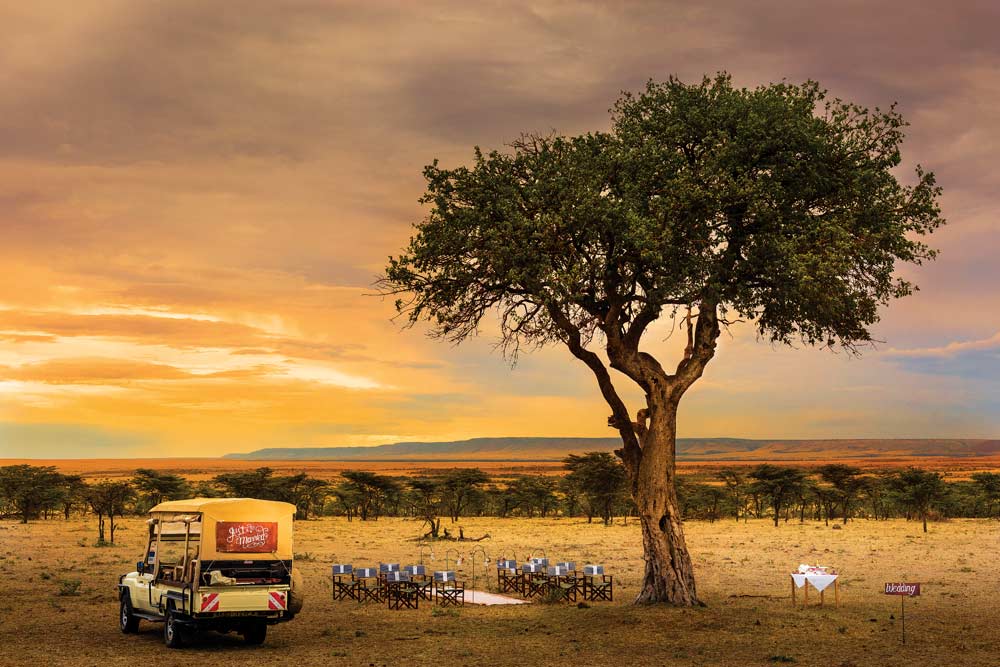
Most lodges can arrange the ceremony for you (provided they hold a special license to host such events). You should give them at least a month’s notice of your wishes so that they can liaise both with the Maasai community and with the Registrar of Marriages. Fees will be payable – but the hotel or lodge can advise you on this.
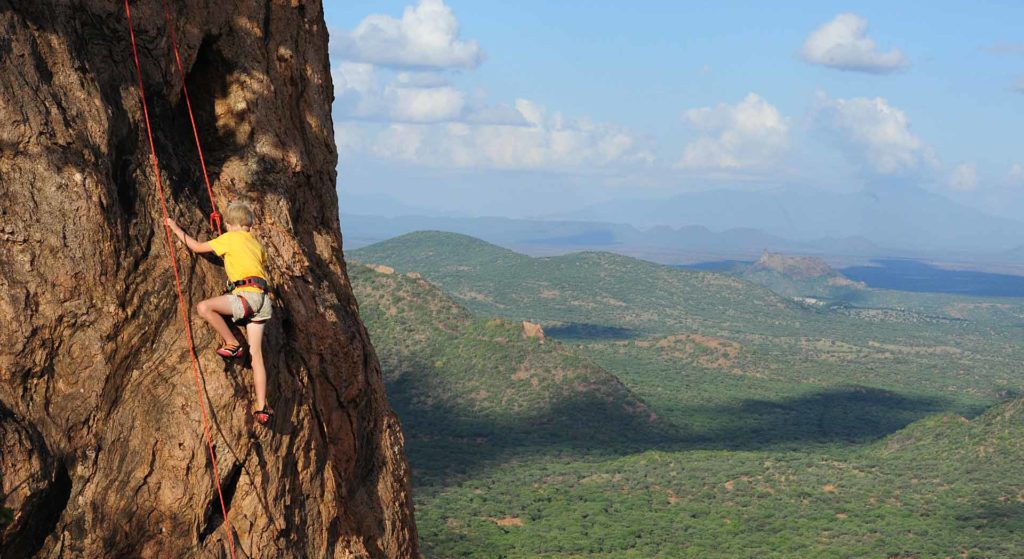
Climbing in Kenya
Climbing in Kenya has a long history and there are many wild and beautiful locations and routes for both beginners and experienced climbers alike. For a family-friendly climb, Mount Longonot is perfect. Kenya also offers excellent cragging and sport climbing. Here are some ideas for a day-out climbing.
Mount Longonot
Best of the volcano climbs is Mount Longonot. The mightiest of the Rift Valley volcanoes, Longonot towers some 2,776 metres above the waters of bewitching Lake Naivasha. Technically dormant, but better described as ‘senile’, Longonot is a relatively young volcano, having been formed within the last 400-600 years. And, while seemingly peaceful, only several thousand meters below its surface the ground water seethes at an incredible 304°C (one of the hottest temperatures on earth).
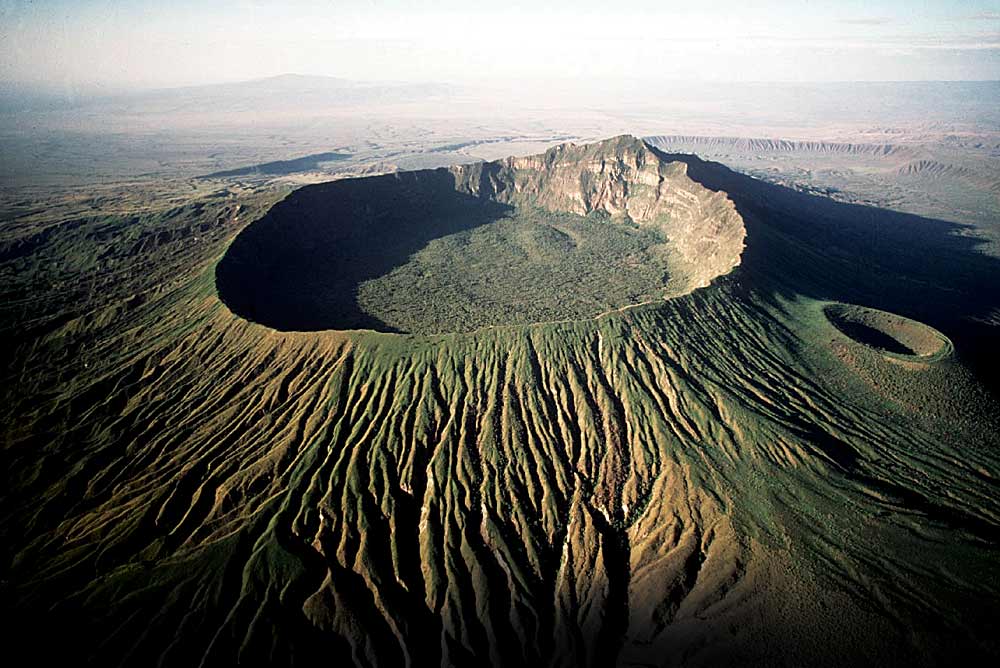
There is a well-defined track that leads, in around 45 minutes of steep scrambling, to the crater rim. The walk is about four kilometres from the car park to the rim, where you gain 700 metres in altitude. Once on top, the view is stunning. You can see both the distant Aberdares Range and the Mau Escarpment. Next you can strike off around the rim. For the shortest route from the crater rim to the summit, follow the rim in an anticlockwise direction for about 10 kilometres – it takes about three hours. The height of the summit is 2,776 metres so the air does get a little thin. A small plateau on the flank of the highest point makes for a spectacular picnic spot.
Longonot is perfect for adults and kids and anyone moderately fit can reach the rim. Longonot stands within its own national park, 90km northwest of Nairobi.
Rock climbing in Hell's Gate National Park
You don’t need much, if any, rock-climbing experience to scale Fischer’s Tower, the main attraction in Hell's Gate National Park. Simply pitch up, pay a very modest fee, and the climbing guide will fit you up with ropes, shoes and the other tricks of the trade. And then he/she will teach you how to climb this 25m-high jagged volcanic plug. Fischer's Tower is all that remains of an ancient volcano, the rock is named after the German explorer, Gustav Fischer, who passed this way in 1883.
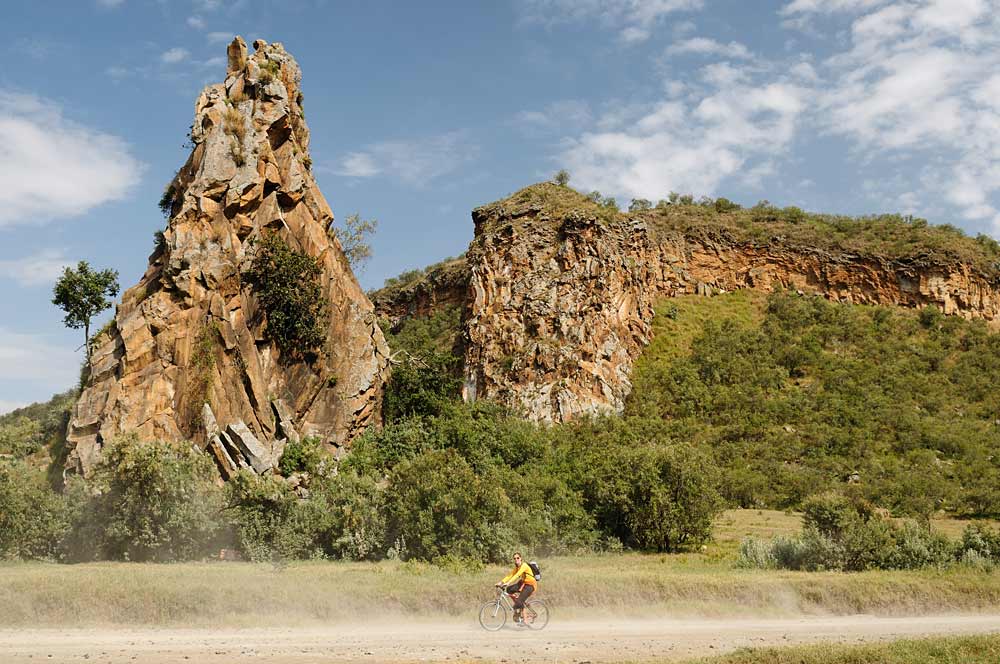
According to local Maasai tradition, the rock is the petrified figure of a chief’s daughter. She turned around, against the dictates of tradition, to take one last look at her home before leaving to be married.
Hell's Gate also offers some excellent big wall traditional rock climbing for the more experienced climbers. Climbs include the Olympian, a well-protected 8-pitch 175m climb.
Hell's Gate National Park is 100km (an hour and a half by road) north of Nairobi and immediately adjacent to Lake Naivasha.
The Elephant Rocks of Tsavo
Equidistant between Nairobi and the coast (275km from Nairobi), Tsavo is one of the largest national parks in the world. It also promises some excellent remote bush climbs such as Kichwa Tembo and The Elephant Rocks, both of which have documented routes ranging from 100 to 300m long.
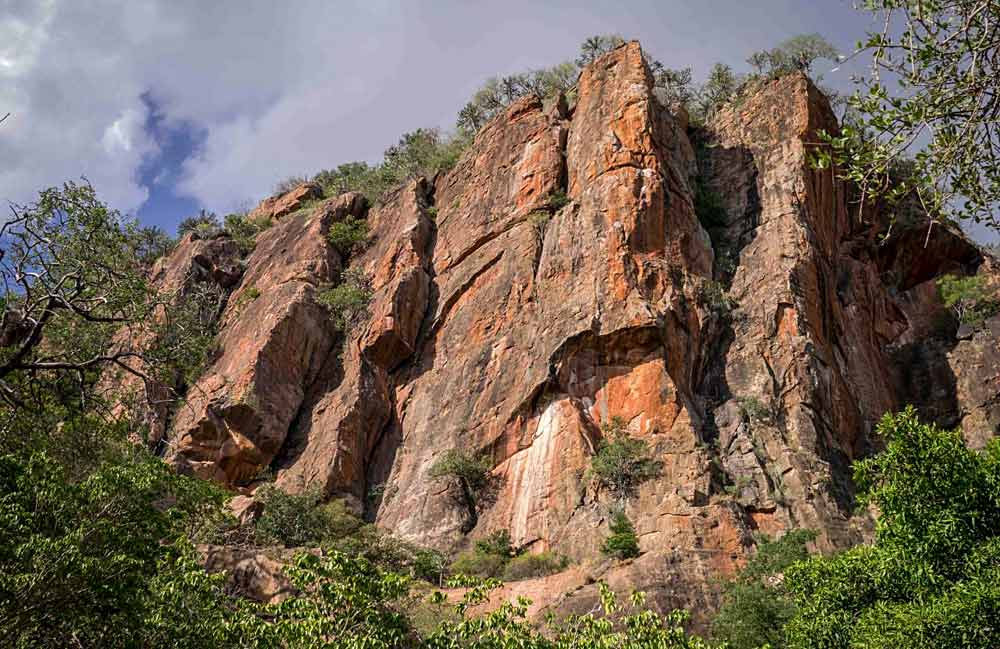
Due to the presence of wildlife, especially lions, climbers must contact Kenya Wildlife Service to arrange for accompaniment by rangers.
Lukenya
According to the Mountain Club of Kenya, the most popular crag in Kenya is Lukenya, a group of cliffs located just 45 minutes south of Nairobi. The Club owns the land on which most of the cliffs are located. Access is free for members and arrangements can be made for visitors to get temporary or daily membership. Lukenya offers a variety of climbing routes including face climbs, some jamming cracks, and overhangs in difficulty ratings of up to E4 6b.
Find out more
For more information on climbing in Kenya, visit the Mountain Club of Kenya website: www.mck.or.ke
Note: the MCK is a members-run, non-profit club and does not offer guiding services directly.
Kenya Wildlife Service website: www.kws.go.ke
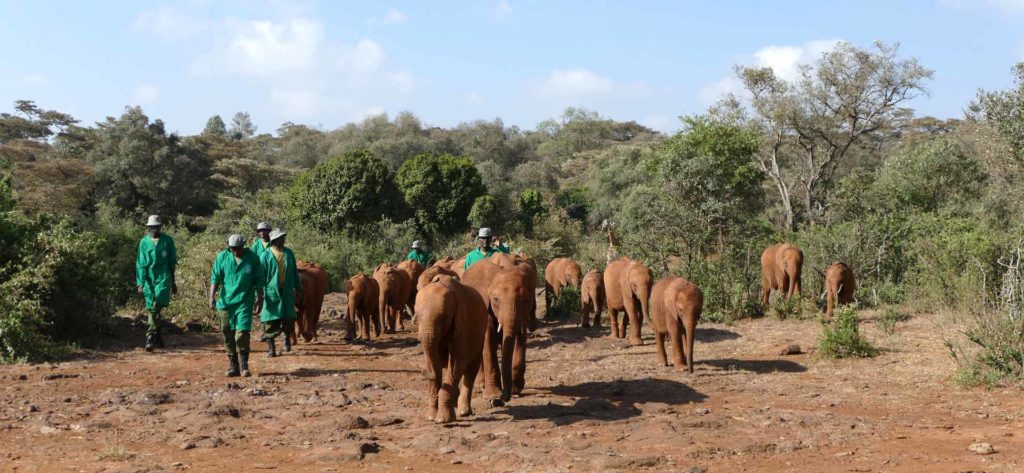
Things to do in Nairobi
Whether you begin or end your trip in Nairobi, there’s plenty to do and see: for an hour, a morning, or a full day. Below are just some of Nairobi's most popular day trips.
Nairobi City Tour
The best way to discover the vibrant diversity of this historic city, which is the uncontested ‘Safari Capital of the World’ and self-styled ‘Green City in the Sun’, is on a City Tour. Travel straight to the heart of Kenyan culture by visiting art galleries, handicraft centers and bustling markets. Gain a unique insight into both Kenya’s past and present by seeing the Parliament Building, Jomo Kenyatta’s mausoleum, the iconic Kenyatta International Convention Center, the Railway Museum (background to the ‘Lunatic Line’ and man-eaters of Tsavo), and the stunningly renovated National Museum of Kenya as well as its Arboretum and Snake Park. Just a few of the city's famous ‘sights’ on offer.
As well as bus tours, there are also walking tours of Nairobi - many of which include a stop for a traditional Kenyan lunch. It is also possible to take a tour of Kibera slum to visit its workshops, vendors and schools and to learn how the slum's 250,000 residents live on a day-to-day basis.
Tours can be booked direct with your hotel.
Sheldrick Wildlife Trust, Langata
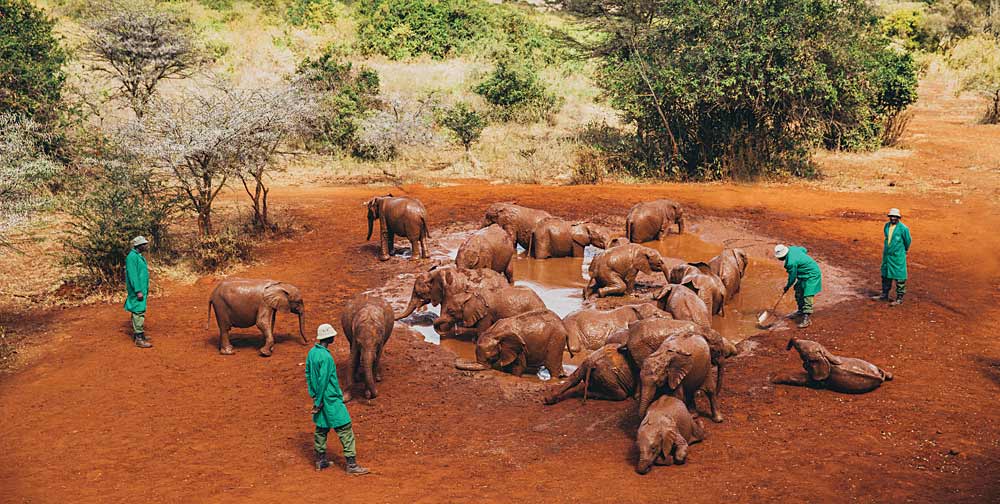
This makes a wonderful morning’s outing to see the baby elephants and rhinos which have been rescued by the Trust. Once the elephants have become reasonably self-sufficient, they are translocated to Tsavo East where they join the older orphans. On this magical visit you can see the baby elephants being fed by their keepers; and watch as they play together in the mud. You can even adopt an elephant.
For further information, read our article on the Trust.
AFEW Giraffe Centre, Langata
An African Fund for Endangered Wildlife project, the Giraffe Centre is a circular wooden building raised on stilts amid pleasant grounds. In the middle is an information centre, around it a platform that allows you to look eye to eye with a Rothschild’s giraffe; and feed it on pony nuts. There’s also a small café on site.
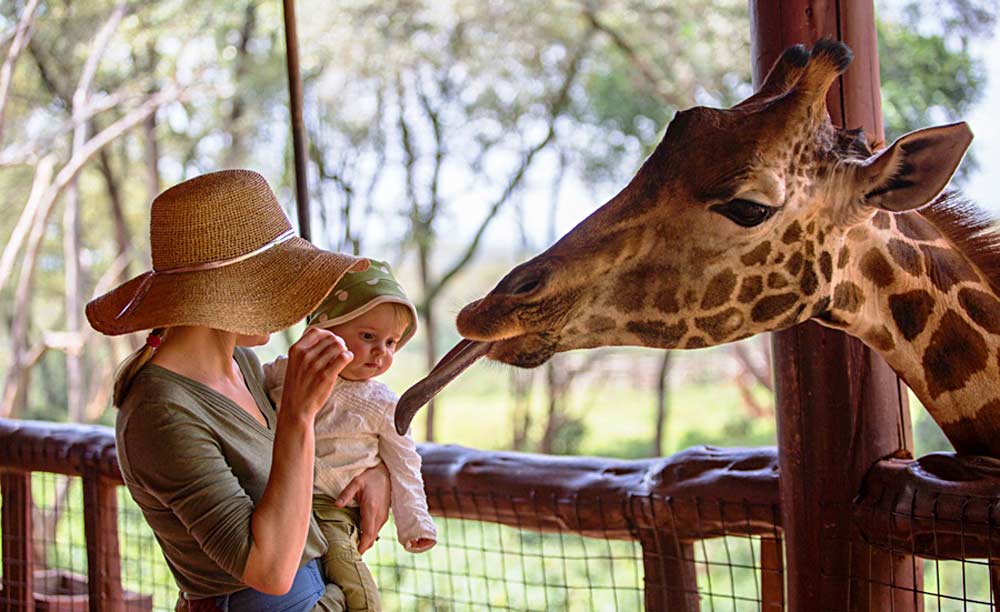
Next door to the centre is Giraffe Manor, a boutique hotel where the giraffes famously poke their heads through the windows to join the guests for breakfast. For more information: www.giraffecentre.org
Nairobi National Park
Just 10 minutes from the city centre, Nairobi National Park is unique. An oasis of green and rolling plains it offers over 100 recorded species of wildlife to include rhino, buffalo, lion, leopard, crocodile and hippo. The Park can be negotiated by 2WD vehicle and offers a mini Kenyan safari, which can easily be done in a morning.
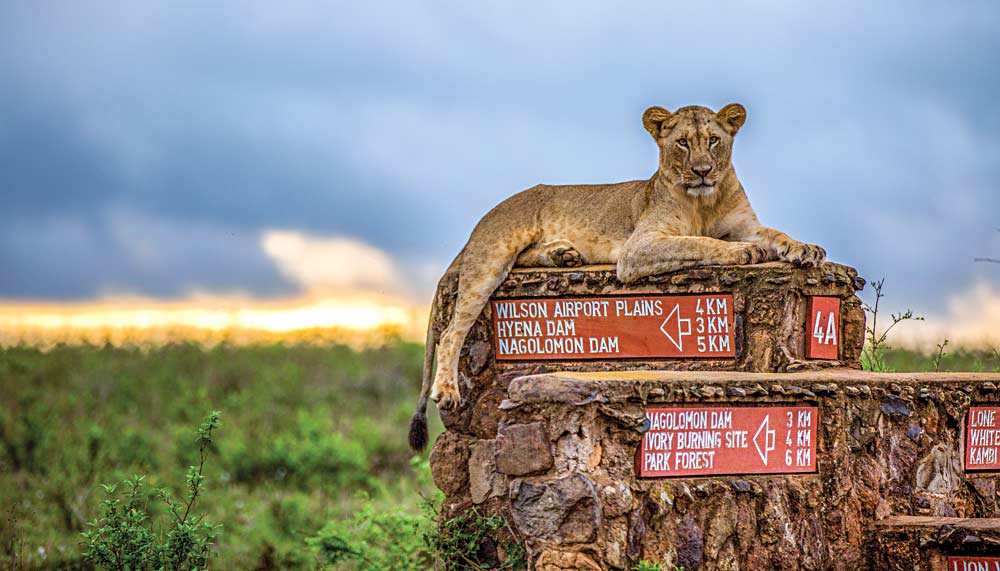
Animal Orphanage & Safari Walk
The Animal Orphanage is located just within the Nairobi National Park. It was established in 1964 as a refuge for sick and orphaned animals, and is a tremendous attraction. The Nairobi Safari Walk is constructed on the Orphanage’s original site, and is designed to reflect Kenya’s ecosystem in miniature. It provides an opportunity to see animals behaving as they would in their natural habitat, and visitors can walk it in 45 minutes or take all day if they wish - a perfect introduction to the safari experience. Guides are available free of charge. A children’s museum and animal feeding time (2.30p.m. daily) as well as a café will keep children occupied for hours.
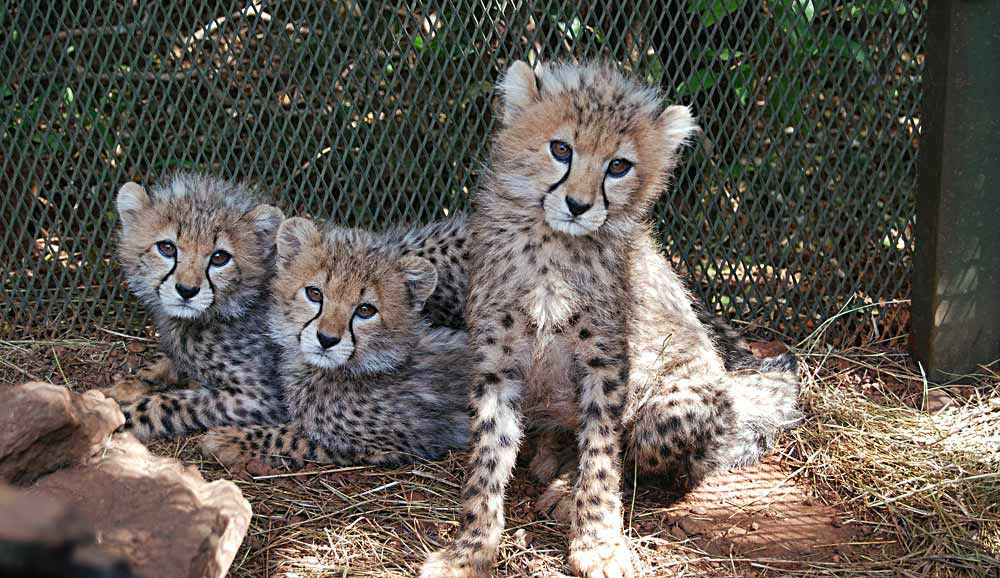
Guided bird and nature walks can be organised in the Park led by members of the Friends of Nairobi National Park (FONNAP) who can be contacted through the Kenya Wildlife Service (KWS) Park Headquarters or by visiting: https://fonnap.org
Nairobi Arboretum and bird walks
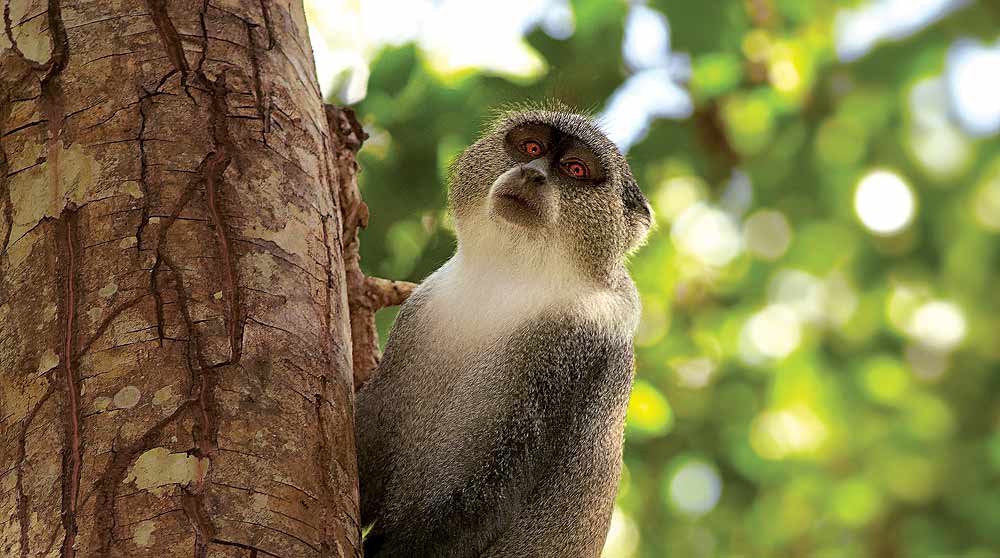
The Arboretum is one of Nairobi’s few remaining green spots with shaded walkways, lawns and jogging trails right at the heart of the city. It comprises 30 hectares of attractive wooded landscape and holds over 350 species of indigenous and exotic plants. It is home to over 100 species of bird, Vervet and Sykes monkeys, many butterflies and other smaller wildlife.
Nature Kenya: a society supporting local community projects ranging from plants to butterflies and birds conducts guided walks in the Arboretum. So allow a morning when you’re in Nairobi and join a bird walk with other enthusiasts. For more information: www.naturekenya.org
The Bomas of Kenya
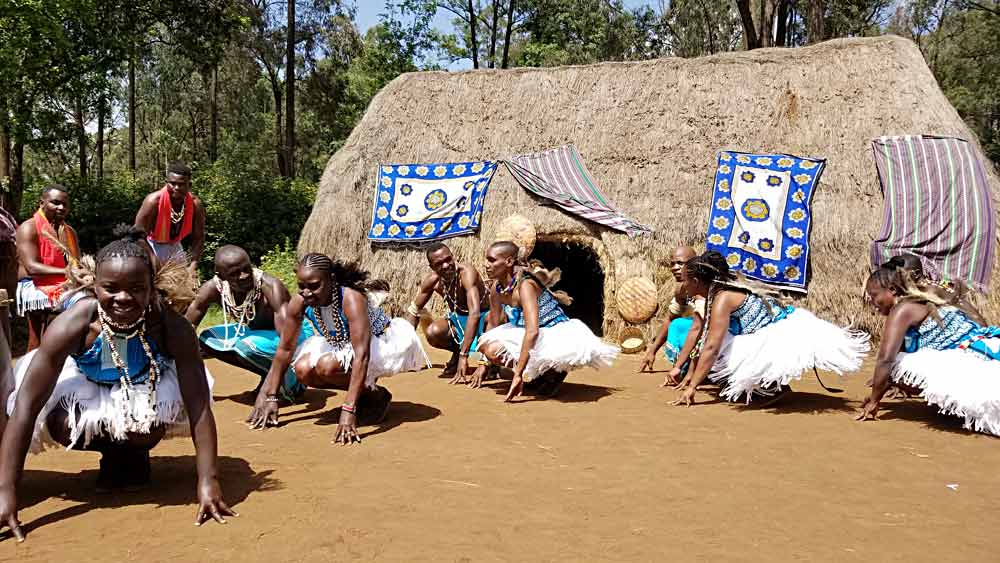
A cultural and entertainment centre, the Bomas of Kenya offer a presentation of African culture and dance. The ‘Harambee’ dancers give displays of different tribal dances, and play an assortment of traditional musical instruments. There’s also an African theme village and the ‘Nyama Choma Boma’ restaurant serving traditional Kenyan food.
For more information, read our article on the Bomas of Kenya.
Karen Blixen Museum
Danish author Karen Blixen, best known for her book Out of Africa, lived in this house on the outskirts of Nairobi which has now been turned into a museum in her honour. The garden’s spectacular view looks out towards the famous Ngong Hills, where Karen’s beloved Dennis Finch-Hatton is buried. Much of the furniture originally belonged to the house.

Approximately 45 minutes from Nairobi, the tour of the museum is however long visitors want to make it. It can often be combined with other stop-offs on what is known locally as ‘The Karen Circuit’. It is one of the National Museums of Kenya’s most popular venues. The Museum has its own shop which includes copies of Karen Blixen’s books written in her pen name, Isak Dinesen. Open every day of the week from 8.30a.m. – 5.00p.m. Visit: www.museums.or.ke for more information.
The Carnivore Experience
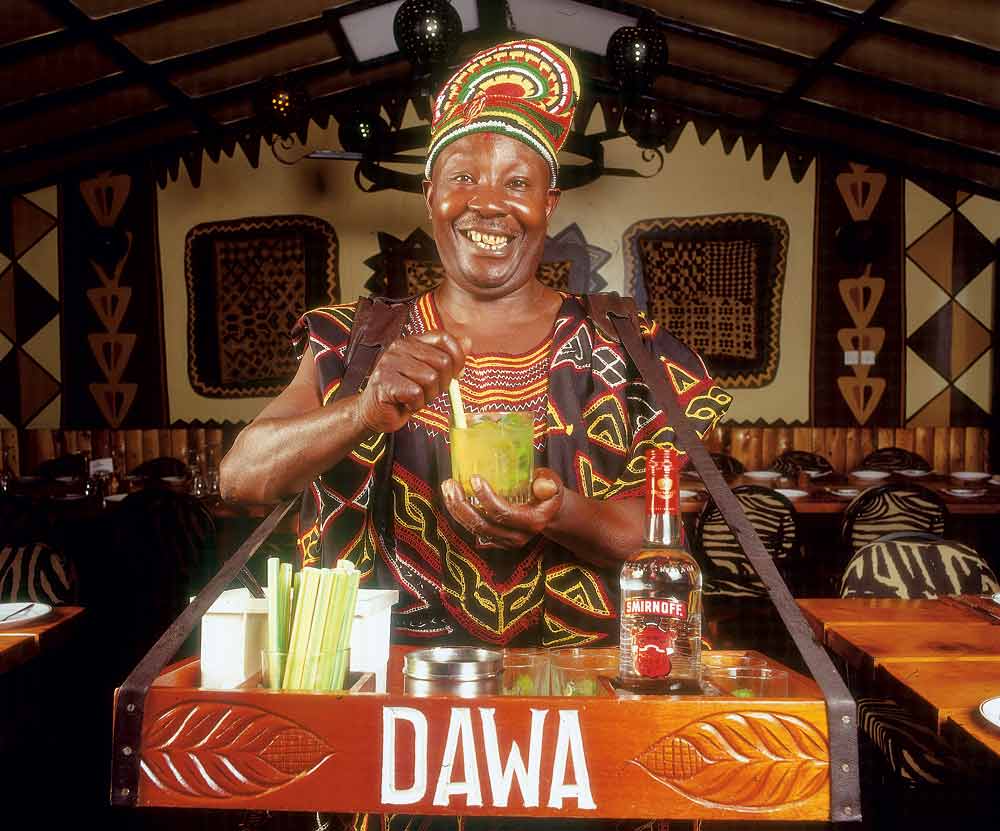
No trip to Nairobi is complete without a visit to the world-famous Carnivore Restaurant (frequently listed as one of the best restaurants in the world). In entirely unique surroundings, you can get your safari off to a really intrepid start (or a truly carnivorous end) with a famous ‘dawa’ cocktail followed by such hunter’s delights as: ostrich, camel and crocodile steaks seared over red-hot furnaces and served on skewers at your table. For the more faint-hearted there are plenty of fish and vegetarian choices too. For bookings: visit the Tamarind website.
Kazuri Beads Factory
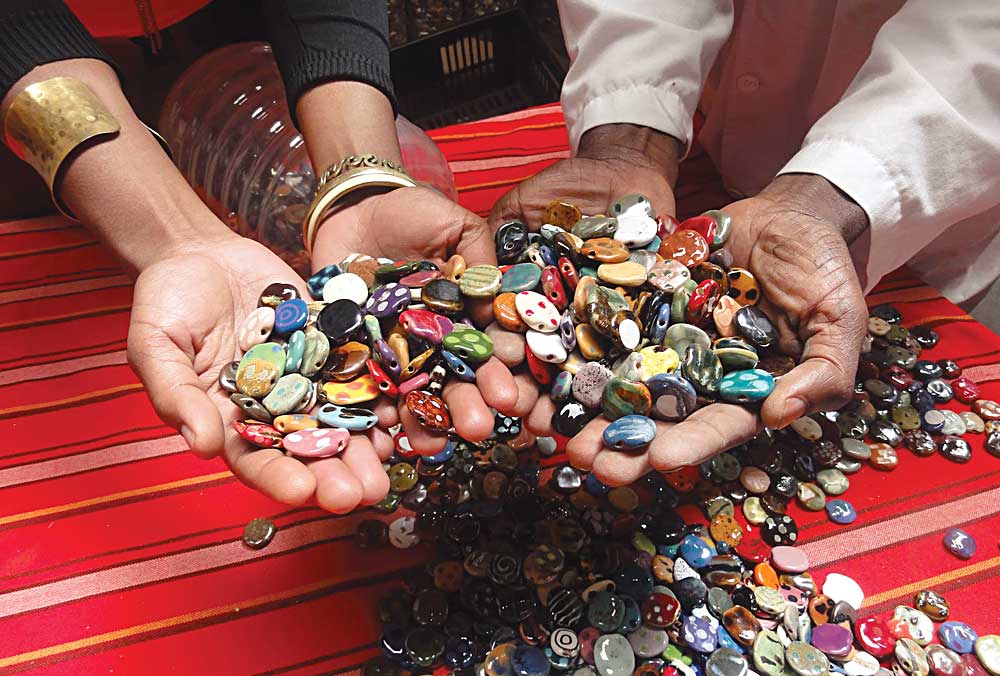
Allow a couple of hours for this visit which entails a tour of the bead factory and a browse round the shop. Watching how the beads are made comes with a fascinating history. In 1975 the late Lady Wood began making ceramic beads in her garden shed. Some years later, knowing that there were many single women in the area who desperately needed employment to help support their children, she found herself running a fully operative bead factory with a flourishing export market. Kazuri’s colourful products which include ceramic jewellery and delightful crockery have a hallmark all of their own. For more information: www.kazuri.com
The Kenya Railway Museum
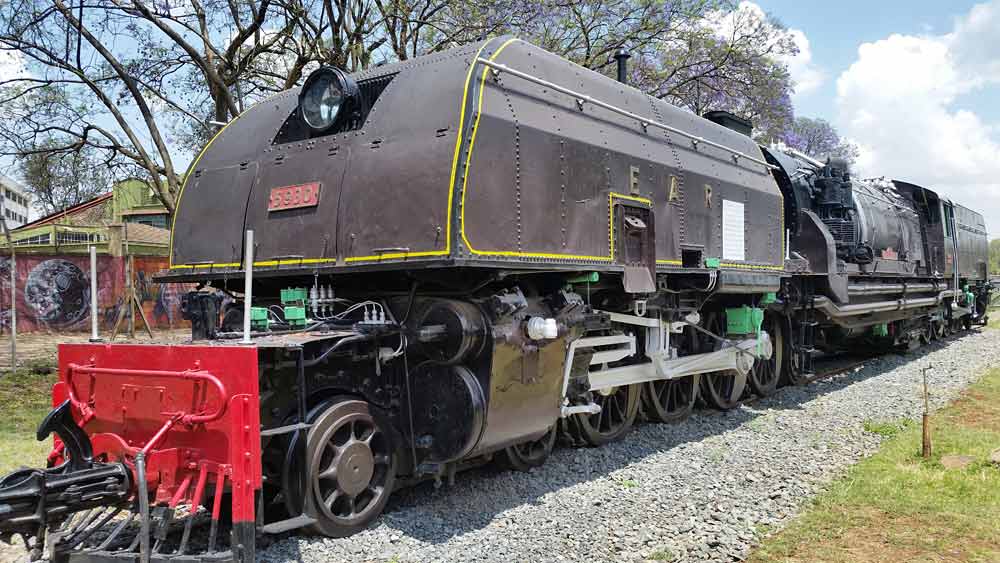
Near the Nairobi Railway Station and easily accessible by taxi, allow at least two hours for a visit. The Museum contains much of Kenya’s early history, is beautifully laid out and of interest to both children and adults. Old locomotives dating back to 1920 are displayed outside together with their carriages. The inside displays are equally interesting and include carriage furniture, crockery, cutlery and menus. For more information, visit the museum's Facebook page.
Kitengela Hot Glass
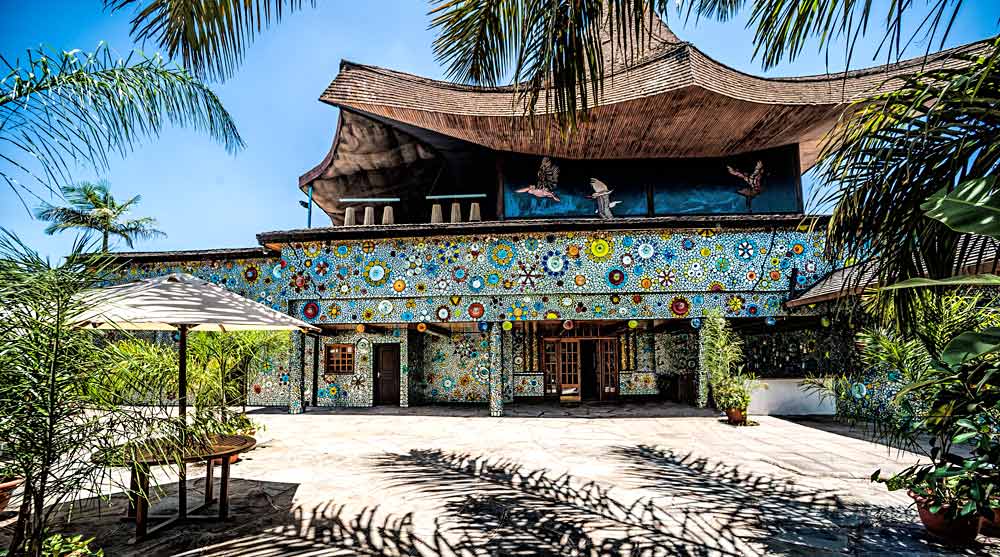
Just an hour’s drive from Nairobi on a rough dirt road, a visit to the Kitengela Hot Glass factory provides an absorbing day out. Located on the edge of Nairobi National Park, this magical group of studios is tucked into the edge of a riverine gorge and consists of an attractive brick beehive structure with a striking planetarium-type dome containing over 1,000 glass stars. Mosaics and glass sculptures line the pathways leading to the gallery stacked with glass treasures.
Visitors have the chance of watching glass blowers at work and can also (with a little notice) enjoy the experience of moulding glass themselves. The range of glassware on sale is enormous – all shapes, sizes and types of glasses, vases, jugs and smaller items. There is also a charming on-site café - the Glasstronomique Café.
For more information: www.kitengela.com
Nairobi National Museum
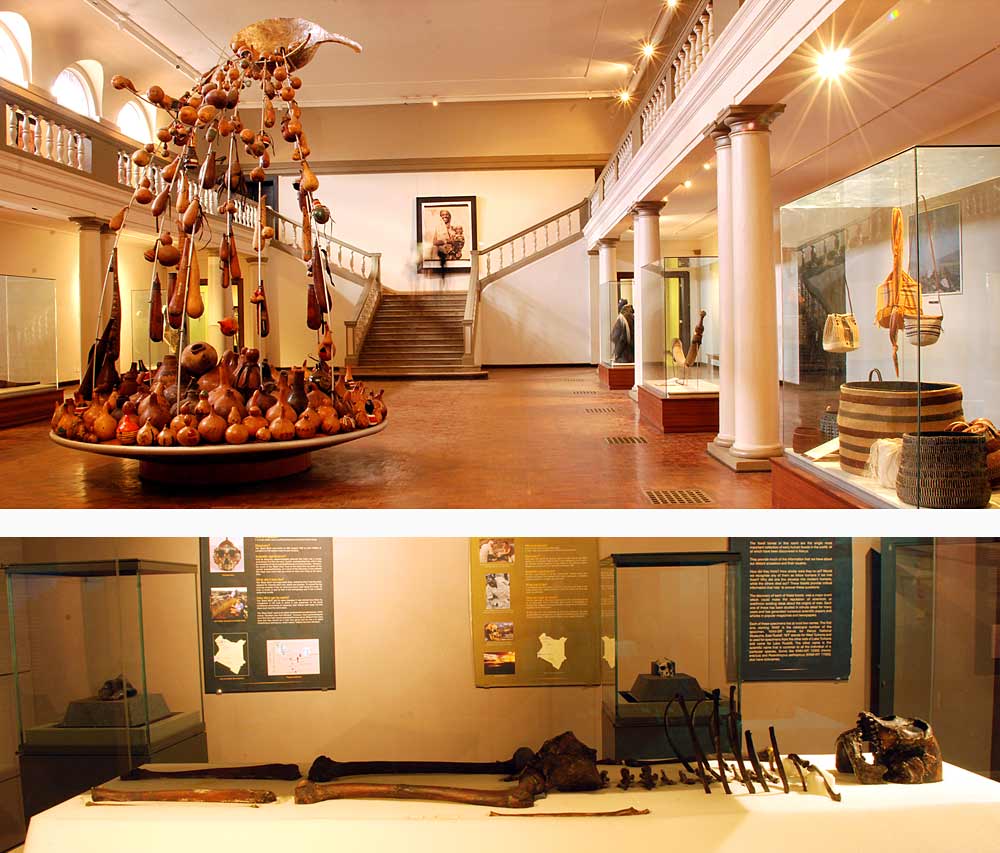
A visit to the recently modernised Nairobi National Museum is a fantastic way to spend time in Nairobi. With greatly expanded and improved display space and exciting new exhibitions, a morning in the museum will give travellers a valuable and meaningful introduction to Kenya’s rich natural and cultural heritage.
Exhibits include the Birds of East Africa - a gallery of nearly 1,000 specimens; the Great Hall of Mammals and the Cradle of Humankind. One of the museum's highlights is the Hominid Skull Room, an incredible collection which is described as ‘the single most important collection of early human fossils in the world’. The most popular exhibit is Turkana Boy (also known as Nariokotome Boy), the almost-complete skeleton of a young boy who lived around 1.5 and 1.6 million years ago, discovered near Lake Turkana in northern Kenya.
Situated within the grounds of the Museum is the Snake Park. It features some impressive snake species including the African rock python, puff adder, black mamba and Egyptian cobra. There is also a botanical garden adorned with sculptures linked to Kenya's heritage.
For further information: www.museums.or.ke and www.kenyamuseumsociety.org
African Heritage
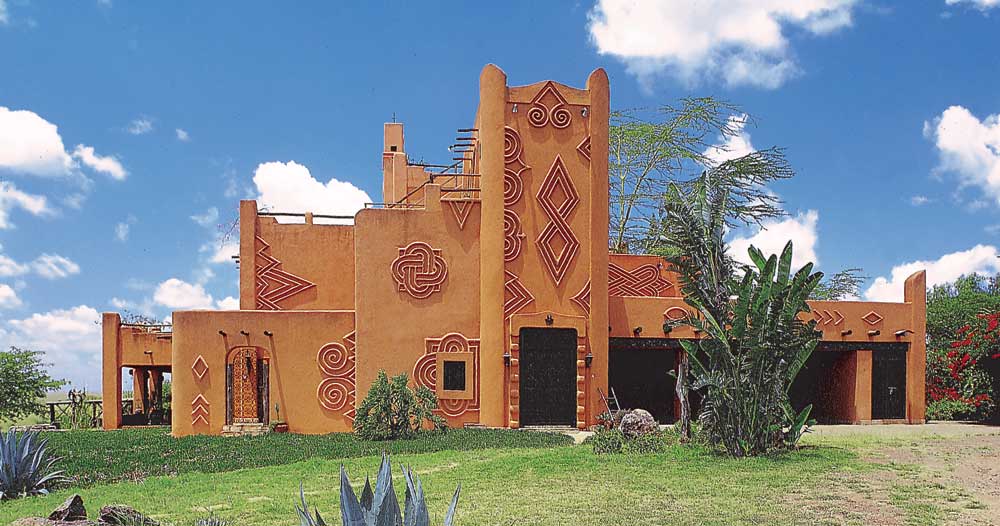
Alan Donovan, one of the main forces in introducing African artefacts, fashions and models to the world has left his collection, currently contained in his house, for visitors to see. Designed by Donovan and overlooking Nairobi National Park, African Heritage House provides the visitor with a true African experience and can be reached either by road or rail, via an original Kenya steam train. A visit can easily include breakfast and lunch as there’s plenty to see. The architecture is traditional; Donovan claims it is “the most photographed house in Africa”. Cultural performances can be arranged with prior notice. For more information: africanheritagehouse.info
Murumbi African Heritage collection
Joe Murumbi of mixed Goan and Maasai parentage and his wife Sheila were among Africa’s most famous collectors of antiquities, and they dedicated their entire lives to collecting Africana. Their world-renowned collection of sculptures, paintings, books, artifacts, historical documents and textiles is on permanent display in the Nairobi Gallery, a National Monument in the centre of Nairobi.
For further information, visit: www.museums.or.ke
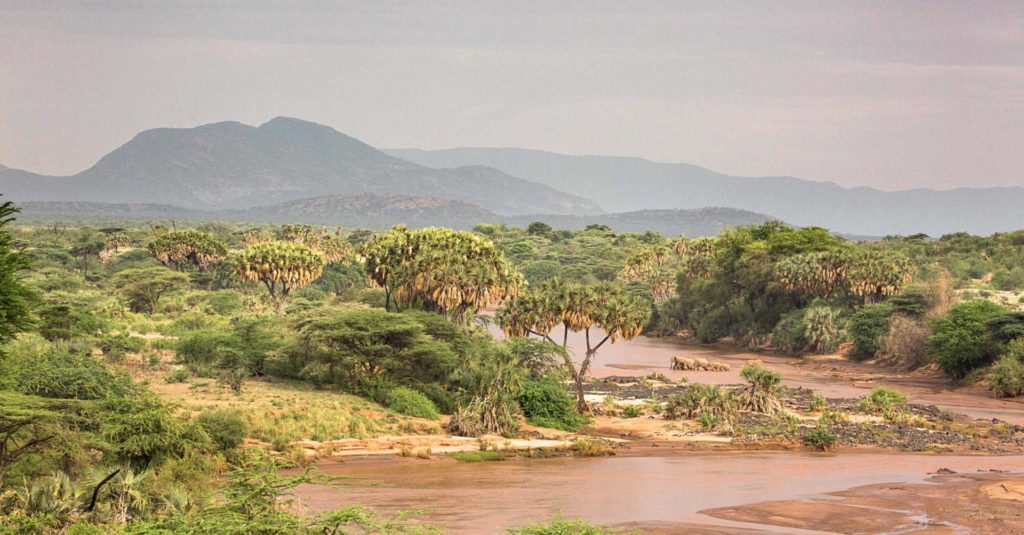
On safari in Buffalo Springs
In the central-northern part of Kenya there is a group of very special national parks. They're so close together so you can explore then all on one trip. In this blog we explore Buffalo Springs, the sister park to Samburu National Reserve and Shaba National Reserve.
The natural swimming pool
The sign reads ‘natural swimming pool’ and points into the middle of the wilderness. We’re in Buffalo Springs National Reserve, one of the triad of northern reserves that also includes Shaba and Samburu. Swimming pools, natural or otherwise, seem unlikely in this searing-hot desert region. We’re surrounded by groves of doum palm, droves of Beisa oryx, drifts of reticulated giraffe and a coronet of purple-tinged mountains, one of which is Ololokwe, the sacred mountain of the Samburu people.
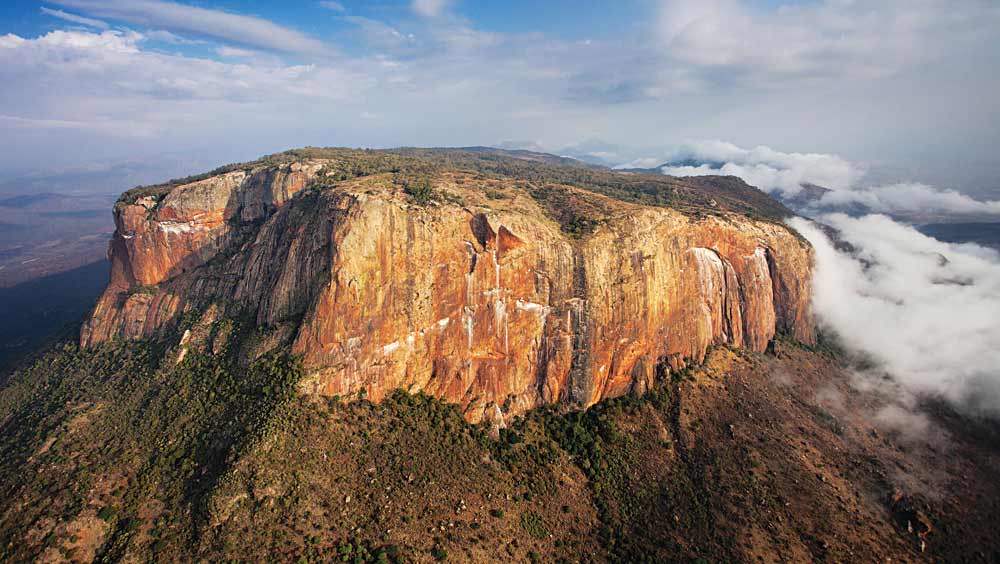
The heat shimmers. But, as the old British military adage has it, ‘time spent on reconnaissance is never wasted’ so we set off for the mythical swimming pool. We don’t have far to go.
There’s a wide swathe of marshland, emerald green and sparkling: it’s one of the many ‘springs’ in which this small (131sq kms) but beautiful land abounds. Beyond the spring there’s a rough circular stonewall about waist height. Behind the wall lies a deep pool. The water is diamond-clear and shines with an otherworldly amethyst blue. A toe in the water reveals it to be bathwater in temperature. The temptation to jump in is overwhelming.
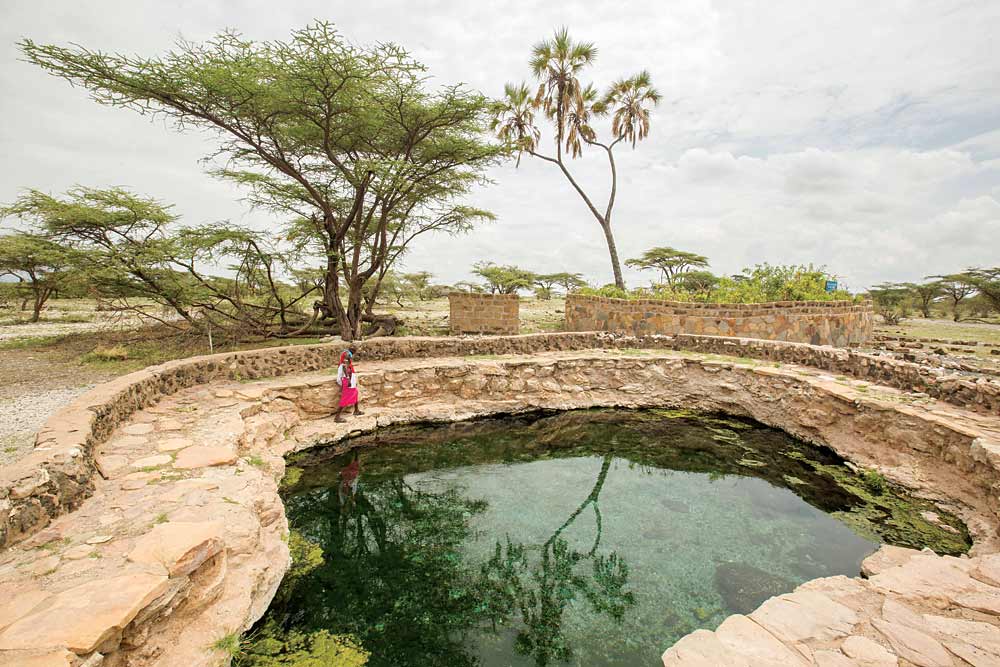
A bomb site
‘It’s a bomb site,’ says our guide. We gape. ‘From World War II,’ he continues. ‘It was 1940 and a squadron of Italian fighter planes were flying back to Ethiopia. They looked down and saw a huge herd of buffalo drinking from this spring. They mistook the buffalo for the tents of the British, who were advancing towards the Ethiopian border, so they dropped a bomb on them’. He regards the huge rocky basin with placid unconcern, ‘and this is what’s left,’ he finishes.
It’s a strange story, but research reveals it to be true. In one of the least-known encounters of the Second World War, Italian Dictator, Benito Mussolini, had declared war on Britain and was attempting to seize what was then British Kenya and Tanganyika for an Italian empire that he declared would be even larger than the Roman Empire. He had 93,000 troops, 232 aircraft and 200 armoured vehicles and tanks. The British had 19,000 troops, six vintage aircraft, with only one serviceable carburettor between them, a couple of homemade armoured cars and no artillery. Surprisingly, the British won. The buffalos, unfortunately, were collateral damage.
Reticulated giraffe and a Beisa oryx
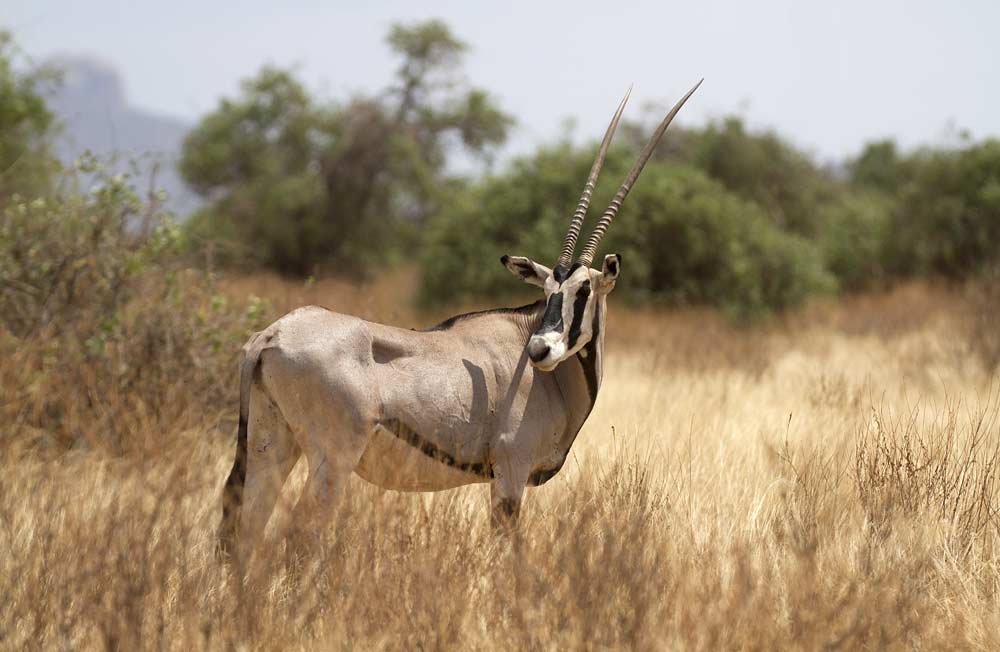
Back at the pool, peace reigns. Three reticulated giraffe stroll past and look us over questioningly. A pair of Canada geese flies in honking loudly and potter in the swamp. A lone Beisa oryx grazes in the near distance, and a train of warthogs trots past with their tails baton-stiff. It’s a gorgeously surreal spot but it’s entirely devoid of shade, so we move on. We’re in search of lions.
And we don’t have far to go to find them either: this park, though small, is seemingly bursting with confrontations. Rounding a corner, we come across a dense clump of bushes. A half-chewed hoof is sticking out of it. Behind the carcass, which appears to have been dragged headlong into the undergrowth, gleams a pair of bright eyes.
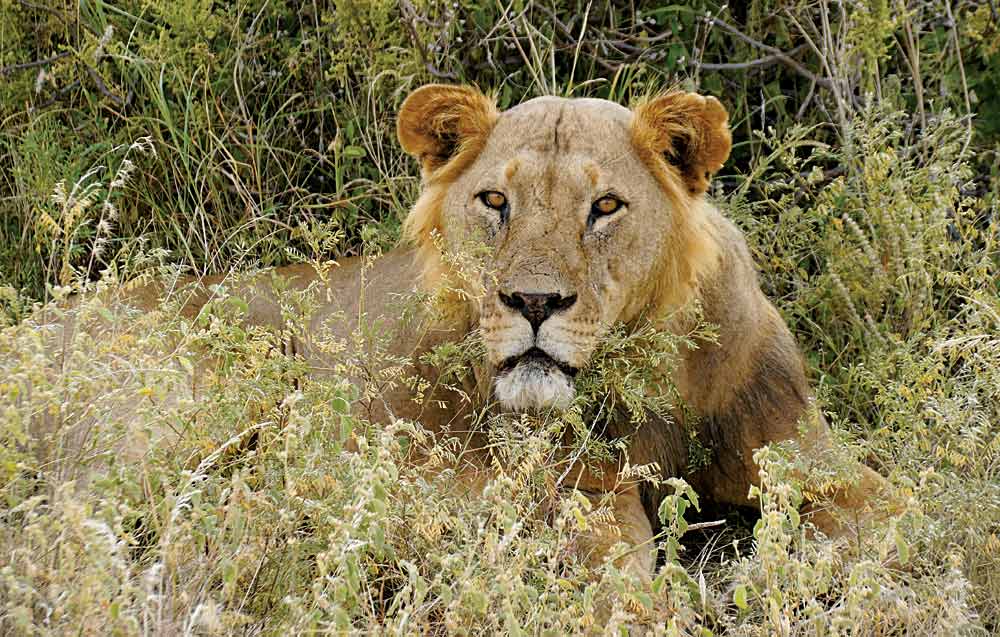
We circle the bush to arrive in a much-trampled arena scattered with standing tufts of tall gold grass. In a bushy den lies a pair of young lions. They’re mane-less, as are all lions in this arid region, and their ears are pricked enquiringly. But they make no attempt to move. ‘There’s another one behind us,’ says our guide. We spin around. Slumped beneath another clump of scrub lies the third young lion. He’s clearly very hot; he’s panting and his ribs heave. The sun catches his eyes; they’re cold and merciless. ‘This is their hunting ground,’ says the guide, ‘it’s a place of ambush’. He’s right. The dusty killing ground is littered with bones and tatters of hide. Clearly the peace of Buffalo Springs is as deceptive now as it was in 1940.
Off the beaten tourist track
And that’s another thing. Though we spend two hours exploring this enchanting landscape, and although we come across troops of wandering elephants, platoons of Somali ostrich and battalions of the rare and endangered Grevy’s zebra, we don’t see another vehicle. And yet, not far away, a stream of vehicles thunders along the great strip of black tarmac that heads north through the Chalbi Desert to Lake Turkana and, ultimately, the Ethiopian border.
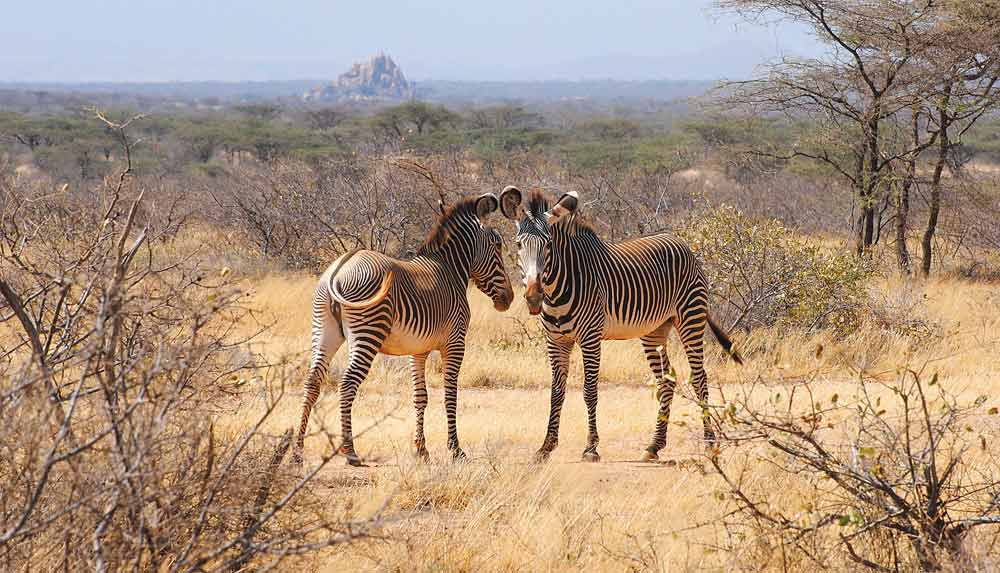
It is said that, as his high-vaunting ambitions crumbled before his eyes, Mussolini declared, ‘I am not a collector of deserts’. Which is perhaps just as well because in April 1941 Addis Ababa fell to the British in a campaign the British War Office described as ‘not so much a war as a well organized miracle’.
The buffalos of Buffalo Springs might have begged to differ.
How to get there
The trio of northern reserves, Samburu, Shaba and Buffalo Springs lie around 340 kms north of Nairobi and are best reached by air. Safarilink offers a number of flights.
What you'll see
Healthy numbers of predators including lion, leopard and cheetah, spotted and striped hyenas, bat-eared fox and hunting dog. Also to be seen: elephant, buffalo, hippo, Burchell’s and Grevy’s zebra, reticulated giraffe, kudu, Beisa oryx, gerenuk, Kirk’s and Gunther’s dik-dik and Bright’s gazelle. There are some 400 bird species including 47 birds of prey, Somali ostrich, vulturine guinea fowl, Verreaux’s eagle-owl, sand-grouse and hornbill.
Where to stay
There are a number of lodges and camps ranging from simple self-catering campsites to five-star lodges. We stayed at Sarova Shaba Game Lodge, which is dramatically located amid natural springs and on the banks of the Ewaso Nyiro River with almost immediate access to all three reserves.
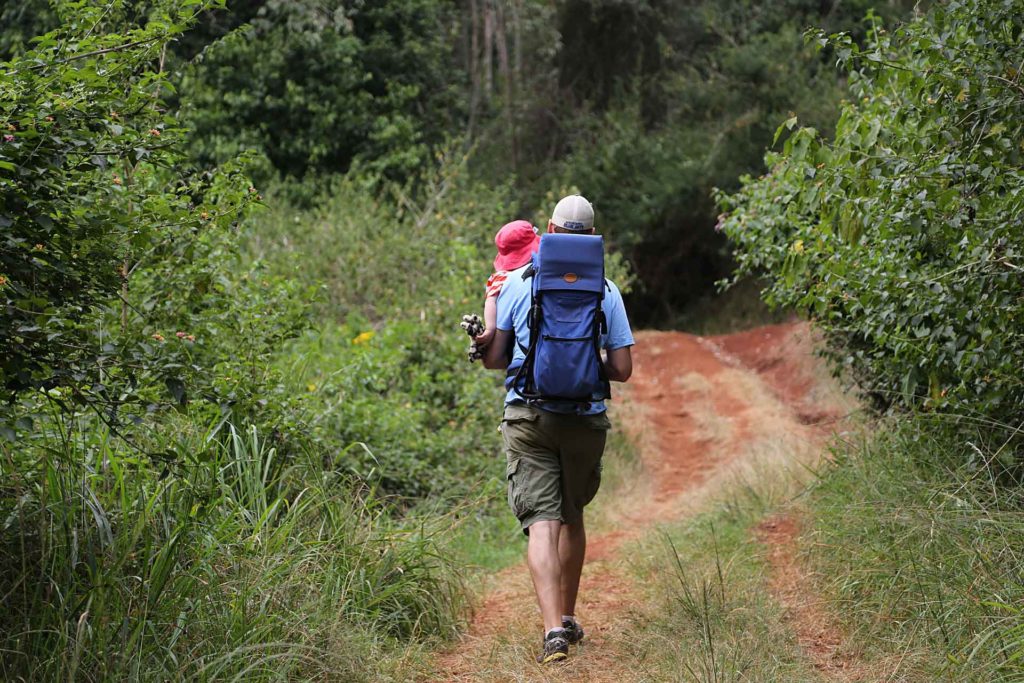
Karura Forest, Nairobi
Karura Forest is full of surprises. It welcomes 16,000 walkers, runners, horse-riders and dog walkers a month. It also occupies fourth-place on the TripAdvisor hit list of ‘what to do in Nairobi.’ Furthermore, it provides a living classroom for thousands of Kenyan school children. And it hosts a selection of events from team building events to weddings and picnics.
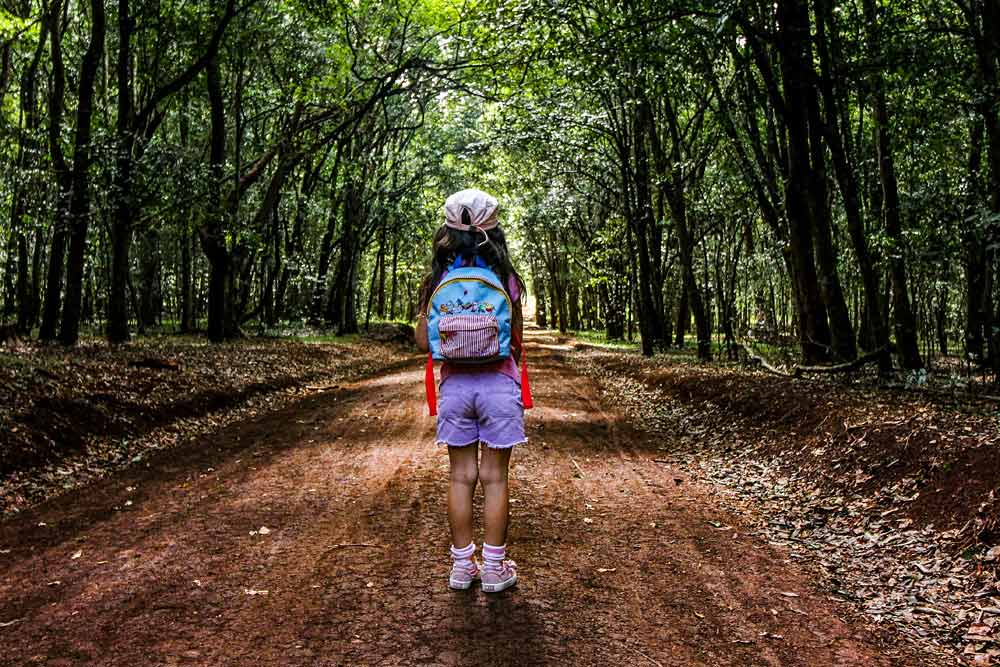
Karura Forest, a place for all seasons and all creatures
There’s a stream of people heading down the narrow suburban road. Ladies in lycra with their eyes on their fitness apps, a crocodile of school children walking hand-in-hand. A pod of cyclists in streamlined helmets. Two young men on horseback and a lot of dogs. They’re on leads, pulling strongly in the direction of their favourite place: the Karura Forest, Nairobi.
Nairobi's green lung
Karura is a calm green space in the very heart of a huge, loud city. Yet, here the air is filled with birdsong and scented with eucalyptus blossom. It’s a friendly place where people smile at you and say ‘hello’. Nine types of orchid nestle amid the trees; and Syke’s monkeys swing from their branches. Nor is it unusual to come across antelopes and bush babies, trogons and turaco.
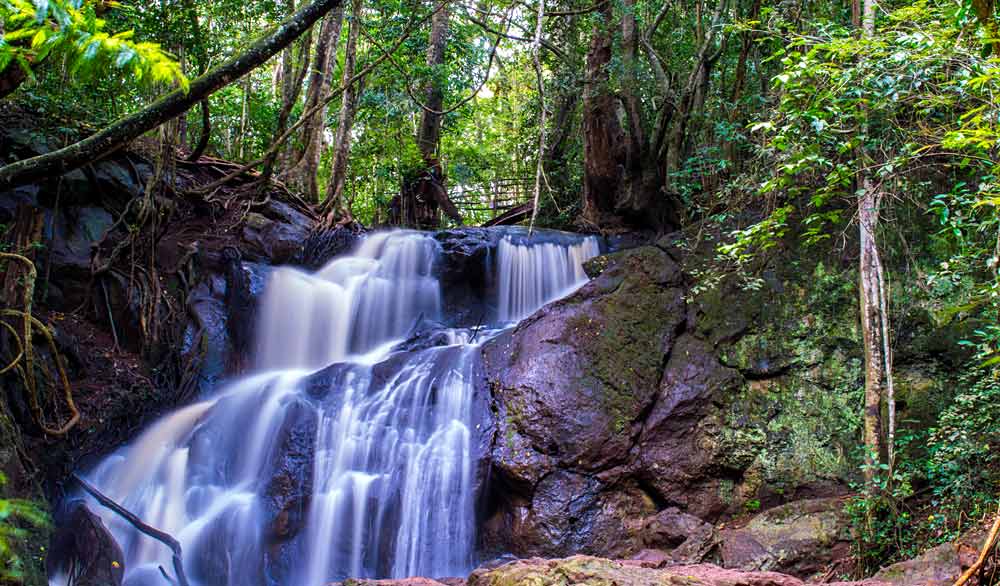
The world’s largest inner-city forest, Karura is Nairobi’s ultimate escape. It promises 50km of colour-coded trails leading through cool forested valleys. Here you can hire a trail bike or leap into a waterfall; you can explore the sacred caves used as hideouts by the Mau Mau freedom fighters during Kenya’s fight for independence. Elsewhere you will find lily ponds and wetlands; even a vast furnace that was once used to burn Kenya’s discontinued currency. There are also several rustic café’s and a children’s adventure park.
Need to know about Karura Forest
Trees include vast stands of eucalyptus as well as all manner of indigenous trees. These include cedar, toothbrush trees, fig trees, bamboo and the East-African greenhearts after which the surrounding Muthaiga district is named.
Wildlife includes suni, Harvey’s duiker, bushbucks and bush pigs. There are also genets, civets, honey badgers, bush babies, porcupines, Syke’s monkeys, bush squirrels, hares and epauletted bat.
There are over 20 species of birds including: Ayres hawk eagle, African crowned eagle, silvery cheeked hornbill, Hartlaub’s turaco, Narina Trogon. African wood owl, crested cranes, sparrows doves, weavers and vultures.
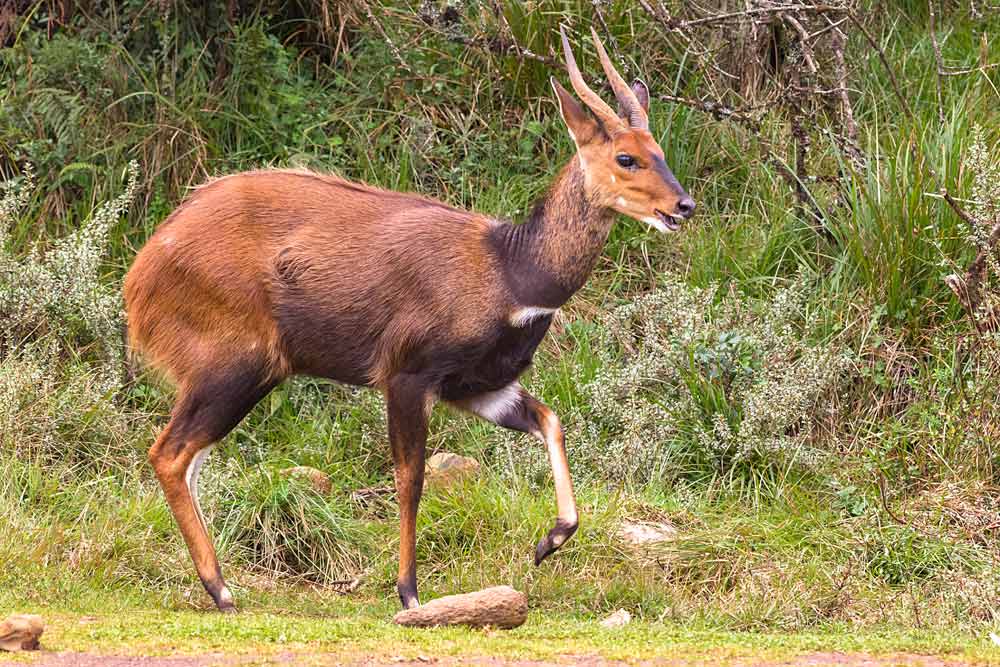
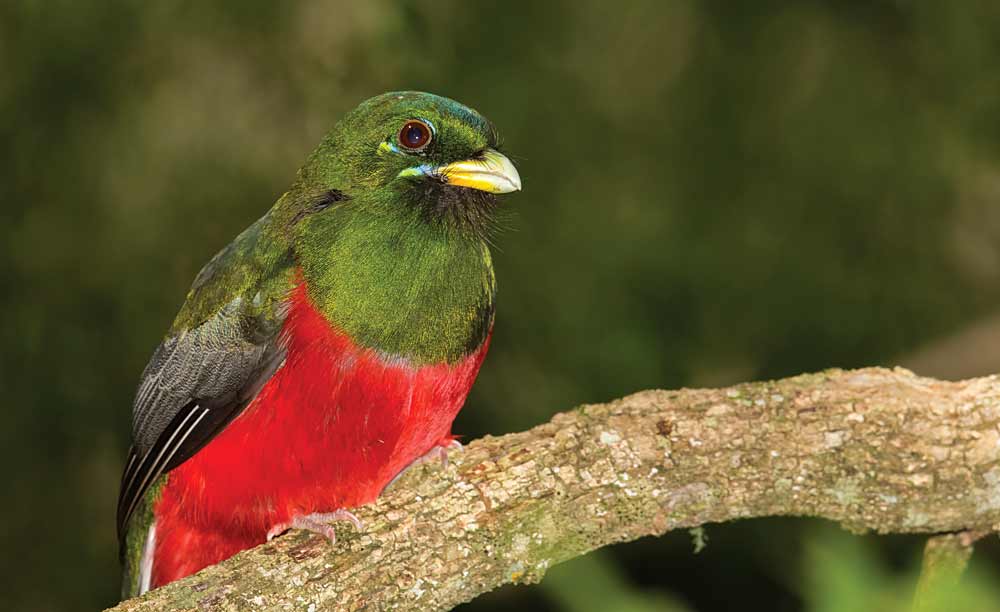
The forest also provides habitat for numerous species of butterflies, including the African Queen and the Desmond’s Green Banded Swallowtail.
Find out more
The Forest has two parking areas: parking costs 100 shillings. Entry fees range from 100 shillings for citizens to 600 shillings for non-residents. It’s open from 6.00am to 5.45pm and sturdy mountain bikes can be hired for 500 shillings for two hours.
For more information: visit the Friends of Karura Forest website
Want Inspiration in your Inbox?
Sign up for FREE to receive our monthly e-newsletter with features
and ideas to help you plan your Kenyan adventure
© 2024 Kenya Holidays
